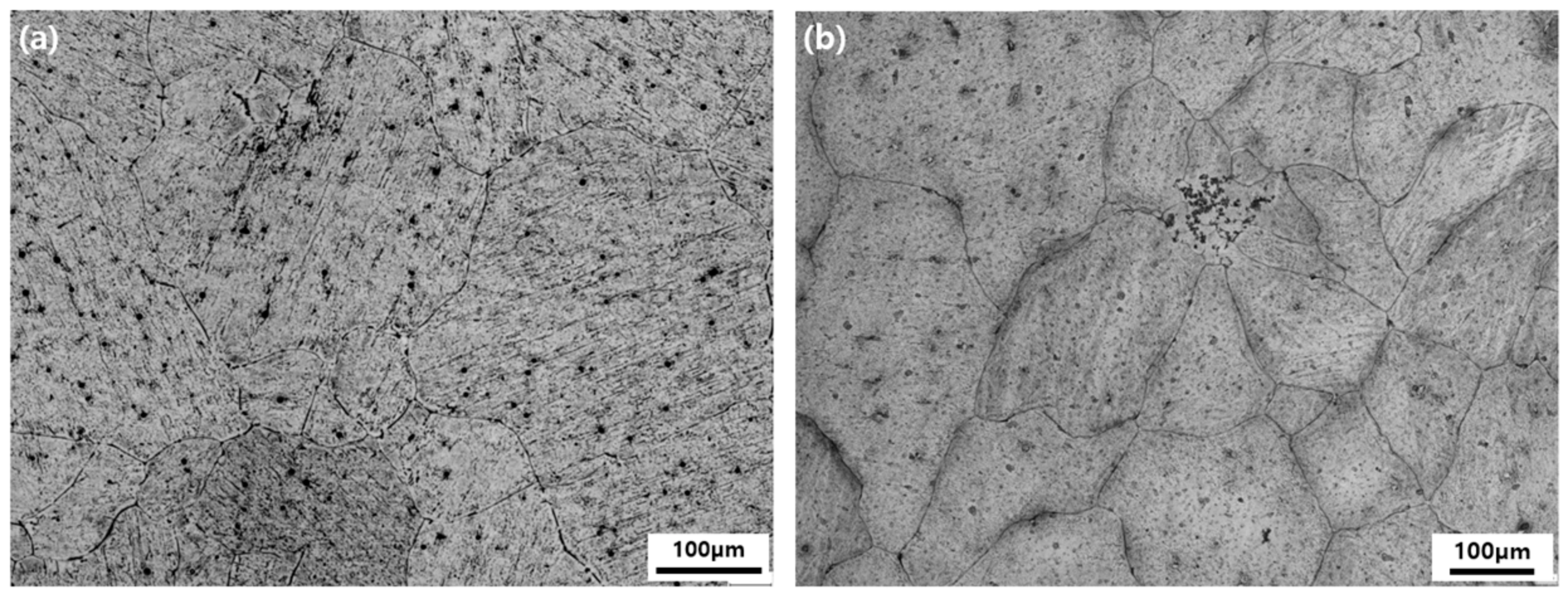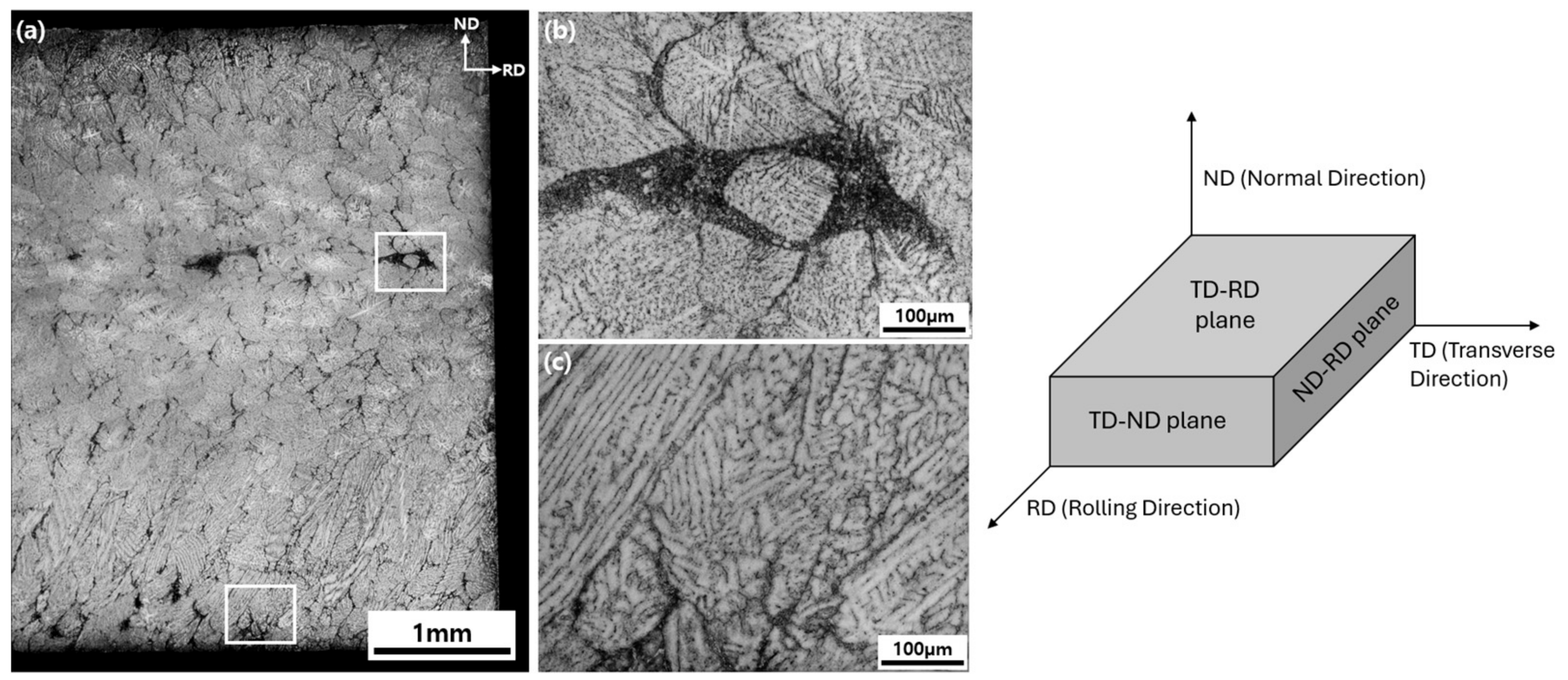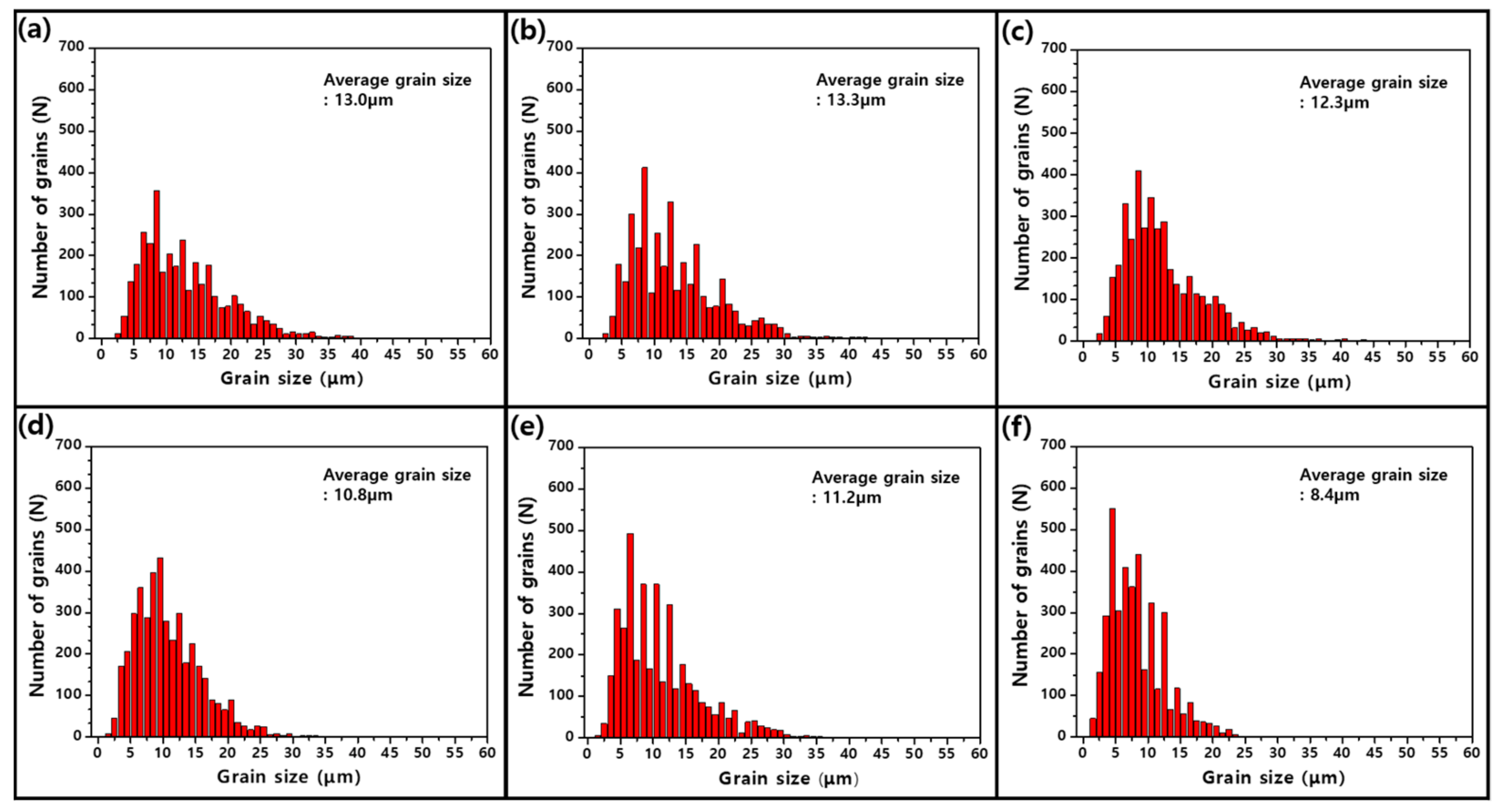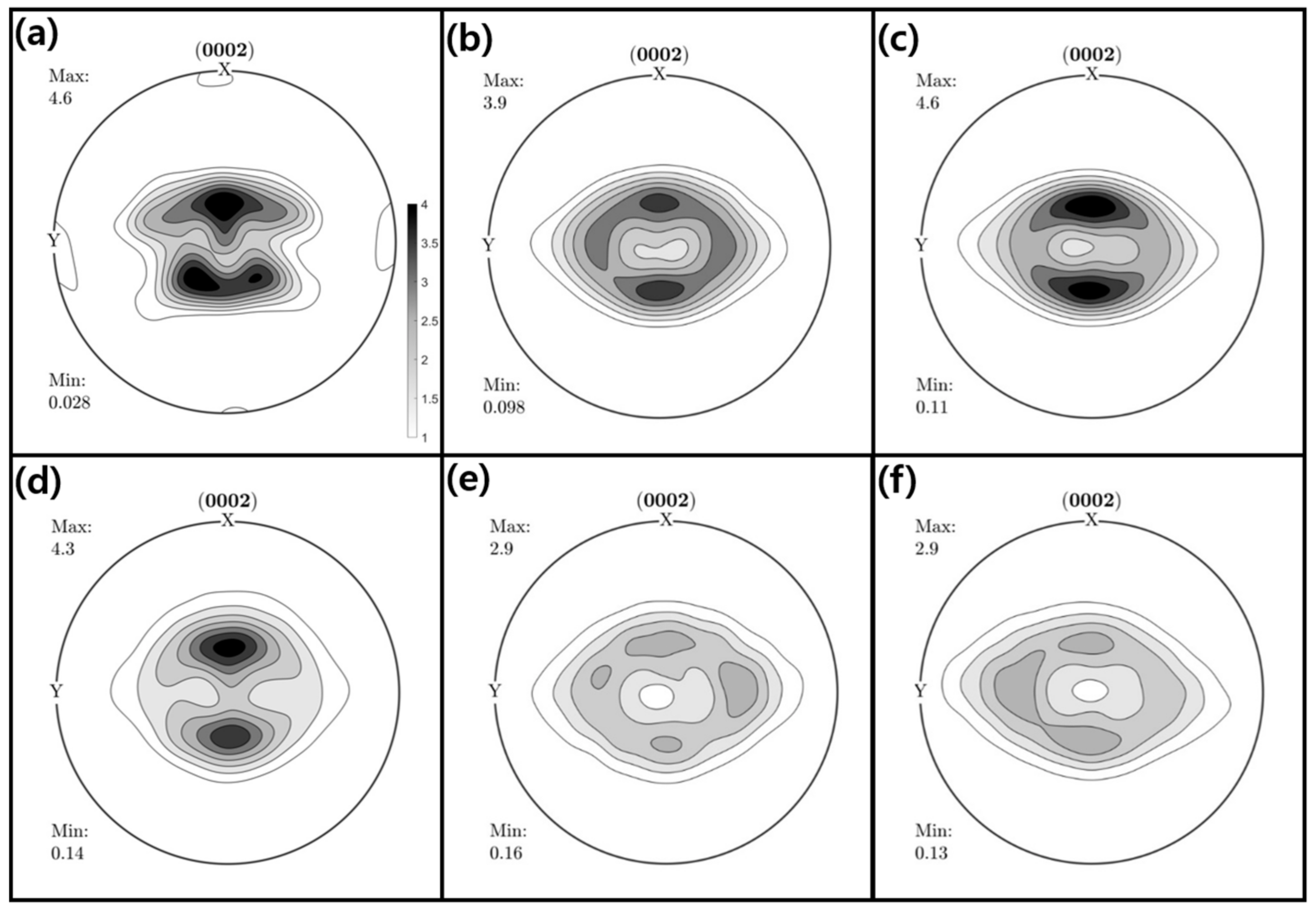Effects of Zn Addition and Twin Roll Casting Process on the Microstructure, Texture, and Mechanical Properties of the Mg-Al-Mn-Ca Sheet
Abstract
1. Introduction
2. Materials and Methods
3. Results and Discussion

4. Conclusions
- In the TRC AZMX1100 sheet, a columnar structure inclined along the rolling direction and centerline segregation was observed, while a coarse grain structure with about 120 µm in average size was formed in the DC cast block. A higher fraction of the second phase was formed in the AMX100 alloy than in the AZMX1100 alloy sheets.
- The TRC AZMX1100 sheet showed the finest grain structure with an average grain size of 8.4 µm, which results from the alloying elements dissolving in the matrix as solid solution at a higher concentration due to the fast cooling rate of the TRC process. The casting AZMX1100 and casting AMX100 sheets show a similar grain size of approximately 11.0 µm. However, a relatively coarse grain structure with a large number of Al2Ca phases is formed in the AMX100 sheet.
- In all the sheets examined in this study, a weak texture with the basal pole spread in the RD or TD was developed. The texture was further weakened by the subsequent heat treatment. The Zn-containing TRC AZMX1100 and casting AZMX1100 sheets showed the basal poles largely tilted in the TD, independent of the process.
- The high YS of the casting AZMX1100 sheet was brought about by the strengthening by the solid solution and fine precipitates, while the highest YS of 174 MPa of the TRC AZMX1100 sheet is additionally attributed to the finer grain size. The planar anisotropy in the yield strength can be understood from the texture of the sheets. For example, the lower YS in the RD of the AMX100 sheet results from the basal poles tilted in the RD, while the lower YS in the TD of the AZMX1100 sheet is associated with the basal poles largely tilted in the TD.
Author Contributions
Funding
Data Availability Statement
Acknowledgments
Conflicts of Interest
References
- Chaudry, U.M.; Tekumalla, S.; Gupta, M.; Jun, T.S.; Hamad, K. Designing highly ductile magnesium alloys: Current status and future challenges. Crit. Rev. Solid State Mater. Sci. 2021, 47, 194–281. [Google Scholar] [CrossRef]
- Joost, W.J.; Krajewski, P.E. Towards magnesium alloys for high-volume automotive applications. Scr. Mater. 2017, 128, 107–112. [Google Scholar] [CrossRef]
- Kim, N.J. Magnesium sheet alloys: Viable alternatives to steels. Mater. Sci. Technol. 2014, 30, 1925–1928. [Google Scholar] [CrossRef]
- Nie, J.F.; Shin, K.S.; Zeng, Z.R. Microstructure, Deformation, and Property of Wrought Magnesium Alloys. Metall. Mater. Trans. A 2020, 51, 6045–6109. [Google Scholar] [CrossRef]
- Javaid, A.; Czerwinski, F. Progress in twin roll casting of magnesium alloys: A review. J. Alloys Compd. 2021, 9, 362–391. [Google Scholar] [CrossRef]
- Park, S.S.; Park, W.J.; Kim, C.H. The Twin-Roll Casting of Magnesium Alloys. JOM 2009, 61, 14–18. [Google Scholar] [CrossRef]
- Cai, Z.X.; Jiang, H.T.; Tang, D.; Ma, Z.; Kang, Q. Texture and stretch formability of rolled Mg-Zn-RE (Y, Ce, and Gd) alloys at room temperature. Rare Met. 2013, 32, 441–447. [Google Scholar] [CrossRef]
- Zhao, L.Q.; Wang, C.; Chen, J.C.; Ning, H.; Yang, Z.Z.; Xu, J.; Wang, H.Y. Development of weak-textured and high-performance Mg-Zn-Ca alloy sheets based on Zn content optimization. J. Alloys Compd. 2020, 849, 156640. [Google Scholar] [CrossRef]
- Nakata, T.; Xu, C.; Suzawa, K.; Yoshida, K.; Kawabe, N.; Kamado, S. Enhancing mechanical properties of rolled Mg-Al-Ca-Mn alloy sheet by Zn addition. Mater. Sci. Eng. A 2018, 737, 223–229. [Google Scholar] [CrossRef]
- Li, Z.H.; Sasaki, T.T.; Bian, M.Z.; Nakata, T.; Yoshida, Y.; Kawabe, N.; Kamado, S.; Hono, K. Role of Zn on the room temperature formability and strength in Mg-Al-Ca-Mn sheet alloys. J. Alloys Compd. 2020, 847, 156347. [Google Scholar] [CrossRef]
- Bian, M.Z.; Sasaki, T.T.; Nakata, T.; Yoshida, Y.; Kawabe, N.; Kamado, S.; Hono, K. Bake-hardenable Mg-Al-Zn-Mn-Ca sheet alloy processed by twin-roll casting. Acta Mater. 2018, 158, 278–288. [Google Scholar] [CrossRef]
- Trang, T.; Zhang, J.; Kim, J.H.; Zargaran, A.; Hwang, J.K.; Suh, B.I.; Kim, N.J. Designing a magnesium alloy with high strength and high formability. Nat. Commun. 2018, 9, 2522. [Google Scholar] [CrossRef] [PubMed]
- Bian, M.Z.; Sasaki, T.T.; Nakata, T.; Kamado, S.; Hono, K. Effects of rolling conditions on the microstructure and mechanical properties in a Mg-Al-Ca-Mn-Zn alloy sheet. Mater. Sci. Eng. A 2018, 730, 147–154. [Google Scholar] [CrossRef]
- Wang, Q.; Jiang, B.; Tang, A.; Fu, J.; Jiang, Z.; Sheng, H.; Zhang, D.; Huang, D.; Pan, F. Unveiling annealing texture formation and static recrystallization kinetics of hot-rolled Mg-Al-Zn-Mn-Ca alloy. Mater. Sci. Technol. 2020, 43, 104–118. [Google Scholar] [CrossRef]
- Hielscher, R.; Schaeben, H. A novel pole figure inversion method: Specification of the MTEX algorithm. Appl. Crystallogr. 2008, 41, 1024–1037. [Google Scholar] [CrossRef]
- Yi, S.; Park, J.H.; Letzig, D.; Kwon, O.D.; Kainer, K.U.; Kim, J.J. Magnesium Technology 2016; Singh, A., Solanki, K., Manuel, M.V., Neelameggham, N.R., Eds.; The Minerals, Metals & Materials Society: Cham, Switzerland, 2016; pp. 383–387. [Google Scholar]
- Steiner, M.A.; Bhattacharyya, J.J.; Agnew, S.R. The origin and enhancement of {0001}<11–20> texture during heat treatment of rolled AZ31B magnesium alloys. Acta Mater. 2015, 95, 443–455. [Google Scholar]
- Jia, X.P.; Hu, X.D.; Zhao, H.Y.; Ju, D.Y.; Chen, D.L. Texture evolution of AZ31 magnesium alloy sheets during warm rolling. J. Alloys Compd. 2015, 645, 70–77. [Google Scholar] [CrossRef]
- Mouhib, F.; Pei, R.; Erol, B.; Sheng, F.; Kerzel, S.K.; Samman, T.A. Synergistic effects of solutes on active deformation modes, grain boundary segregation and texture evolution in Mg-Gd-Zn alloys. Mater. Sci. Eng. A 2022, 847, 143348. [Google Scholar] [CrossRef]
- Kim, Y.M.; Mendis, C.; Sasaki, T.; Letzig, D.; Pyczak, F.; Hono, K.; Yi, S.B. Static recrystallization behaviour of cold rolled Mg-Zn-Y alloy and role of solute segregation in microstructure evolution. Scr. Mater. 2017, 136, 41–45. [Google Scholar] [CrossRef]
- Hoseini-Athar, M.M.; Mahmudi, R.; Babu, R.P.; Hedstrom, P. Microstructure, texture, and strain-hardening behavior of extruded Mg-Gd-Zn alloys. Mater. Sci. Eng. A 2020, 772, 138833. [Google Scholar] [CrossRef]
- Zeng, Z.R.; Zhu, Y.M.; Xu, S.W.; Bian, M.Z.; Davies, C.H.J.; Birbilis, N.; Nie, J.F. Texture evolution during static recrystallization of cold-rolled magnesium alloys. Acta Mater. 2016, 105, 479–494. [Google Scholar] [CrossRef]
- Jiang, Z.; Jiang, B.; Yang, H.; Yang, Q.; Dai, J.; Pan, F. Influence of the Al2Ca phase on microstructure and mechanical properties of Mg-Al-Ca alloys. J. Alloys Compd. 2015, 647, 357–363. [Google Scholar] [CrossRef]








| Alloy | Nominal Composition (wt.%) | Casting Method | Rolling | Recrystallization Annealing |
|---|---|---|---|---|
| Casting AMX100 | Mg-1Al-0.2Mn-0.5Ca | DC casting | Hot rolling at 410 °C, total reduction 79% (common to all alloys) | 350 °C for 120 min (common to all alloys) |
| Casting AZMX1100 | Mg-1Al-1Zn-0.2Mn-0.5Ca | DC casting | ||
| TRC AZMX1100 | Mg-1Al-1Zn-0.2Mn-0.5Ca | Twin roll casting |
| Process | Alloy | RD | TD | ||||
|---|---|---|---|---|---|---|---|
| YS (MPa) | UTS (MPa) | εf (%) | YS (MPa) | UTS (MPa) | εf (%) | ||
| Casting | AMX100 | 137 ± 3 | 216 ± 3 | 21.1 ± 2.5 | 148 ± 3 | 214 ± 3 | 18.2 ± 2.9 |
| AZMX1100 | 153 ± 3 | 237 ± 2 | 22.9 ± 1.3 | 130 ± 4 | 234 ± 4 | 26.9 ± 1.1 | |
| TRC | AZMX1100 | 174 ± 3 | 250 ± 2 | 20.5 ± 1.1 | 151 ± 3 | 244 ± 3 | 23.6 ± 1.2 |
Disclaimer/Publisher’s Note: The statements, opinions and data contained in all publications are solely those of the individual author(s) and contributor(s) and not of MDPI and/or the editor(s). MDPI and/or the editor(s) disclaim responsibility for any injury to people or property resulting from any ideas, methods, instructions or products referred to in the content. |
© 2024 by the authors. Licensee MDPI, Basel, Switzerland. This article is an open access article distributed under the terms and conditions of the Creative Commons Attribution (CC BY) license (https://creativecommons.org/licenses/by/4.0/).
Share and Cite
Eom, D.; Yi, S.; Letzig, D.; Park, N.-J. Effects of Zn Addition and Twin Roll Casting Process on the Microstructure, Texture, and Mechanical Properties of the Mg-Al-Mn-Ca Sheet. Metals 2024, 14, 261. https://doi.org/10.3390/met14030261
Eom D, Yi S, Letzig D, Park N-J. Effects of Zn Addition and Twin Roll Casting Process on the Microstructure, Texture, and Mechanical Properties of the Mg-Al-Mn-Ca Sheet. Metals. 2024; 14(3):261. https://doi.org/10.3390/met14030261
Chicago/Turabian StyleEom, Donghwan, Sangbong Yi, Dietmar Letzig, and No-Jin Park. 2024. "Effects of Zn Addition and Twin Roll Casting Process on the Microstructure, Texture, and Mechanical Properties of the Mg-Al-Mn-Ca Sheet" Metals 14, no. 3: 261. https://doi.org/10.3390/met14030261
APA StyleEom, D., Yi, S., Letzig, D., & Park, N.-J. (2024). Effects of Zn Addition and Twin Roll Casting Process on the Microstructure, Texture, and Mechanical Properties of the Mg-Al-Mn-Ca Sheet. Metals, 14(3), 261. https://doi.org/10.3390/met14030261






